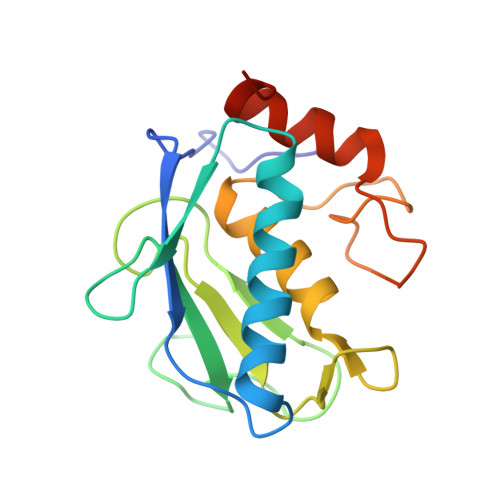Development of new carboxylic acid-based MMP inhibitors derived from functionalized propargylglycines.
Natchus, M.G., Bookland, R.G., Laufersweiler, M.J., Pikul, S., Almstead, N.G., De, B., Janusz, M.J., Hsieh, L.C., Gu, F., Pokross, M.E., Patel, V.S., Garver, S.M., Peng, S.X., Branch, T.M., King, S.L., Baker, T.R., Foltz, D.J., Mieling, G.E.(2001) J Med Chem 44: 1060-1071
- PubMed: 11297453
- DOI: https://doi.org/10.1021/jm000477l
- Primary Citation of Related Structures:
1HY7 - PubMed Abstract:
A series of carboxylic acids were prepared from a propargylglycine scaffold and tested for efficacy as matrix metalloproteinase (MMP) inhibitors. Detailed SAR for the series is reported for four enzymes within the MMP family. The inhibitors were typically potent against collagenase-3 (MMP-13) and gelatinase A (MMP-2), while they spared collagenase-1 (MMP-1) and only moderately inhibited stromelysin (MMP-3). Compound 40 represents a typical inhibition profile of a compound with reasonable potency. Introduction of polar groups was required in order to generate inhibitors with acceptable water solubility, and this often resulted in a loss of potency as in compound 63. High serum protein binding proved to be a difficult hurdle with many compounds such as 48 showing >99% binding. Some compounds such as 64 displayed approximately 90% binding, but no reliable method was discovered for designing molecules with low protein binding. Finally, selected data regarding the pharmacokinetic behavior of these compounds is presented.
- Procter and Gamble Pharmaceuticals, 8700 Mason-Montgomery Road, Mason, Ohio 45040, USA. natchus.mg@pg.com
Organizational Affiliation:



















